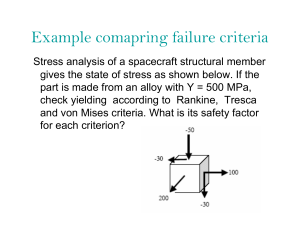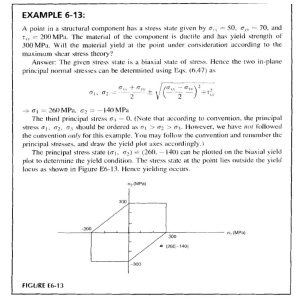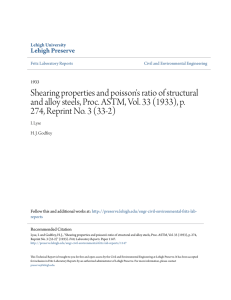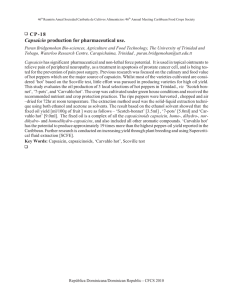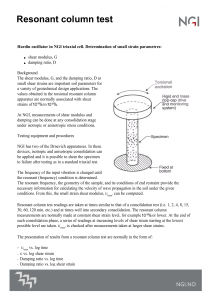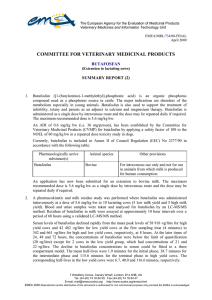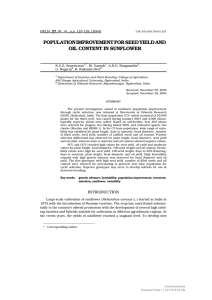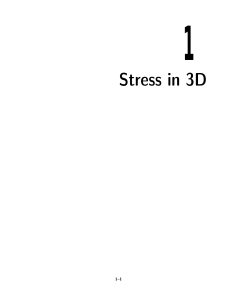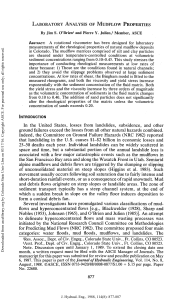Yield Stress Fluids: A Modern Rheological Perspective
Anuncio
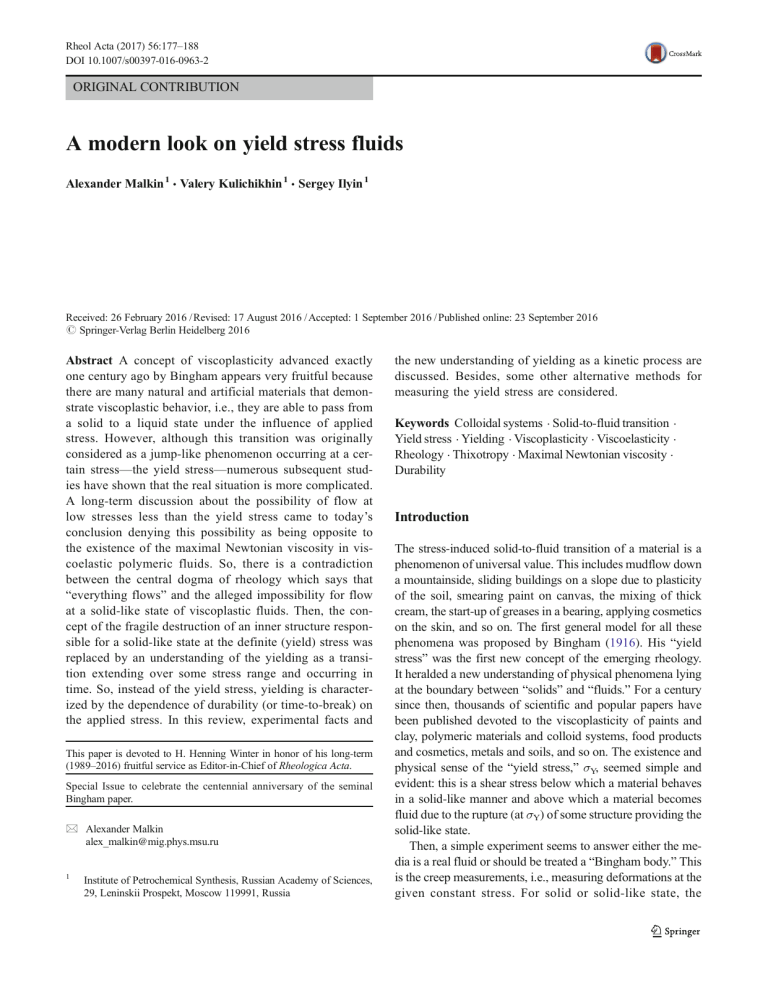
Rheol Acta (2017) 56:177–188 DOI 10.1007/s00397-016-0963-2 ORIGINAL CONTRIBUTION A modern look on yield stress fluids Alexander Malkin 1 & Valery Kulichikhin 1 & Sergey Ilyin 1 Received: 26 February 2016 / Revised: 17 August 2016 / Accepted: 1 September 2016 / Published online: 23 September 2016 # Springer-Verlag Berlin Heidelberg 2016 Abstract A concept of viscoplasticity advanced exactly one century ago by Bingham appears very fruitful because there are many natural and artificial materials that demonstrate viscoplastic behavior, i.e., they are able to pass from a solid to a liquid state under the influence of applied stress. However, although this transition was originally considered as a jump-like phenomenon occurring at a certain stress—the yield stress—numerous subsequent studies have shown that the real situation is more complicated. A long-term discussion about the possibility of flow at low stresses less than the yield stress came to today’s conclusion denying this possibility as being opposite to the existence of the maximal Newtonian viscosity in viscoelastic polymeric fluids. So, there is a contradiction between the central dogma of rheology which says that “everything flows” and the alleged impossibility for flow at a solid-like state of viscoplastic fluids. Then, the concept of the fragile destruction of an inner structure responsible for a solid-like state at the definite (yield) stress was replaced by an understanding of the yielding as a transition extending over some stress range and occurring in time. So, instead of the yield stress, yielding is characterized by the dependence of durability (or time-to-break) on the applied stress. In this review, experimental facts and This paper is devoted to H. Henning Winter in honor of his long-term (1989–2016) fruitful service as Editor-in-Chief of Rheologica Acta. Special Issue to celebrate the centennial anniversary of the seminal Bingham paper. * Alexander Malkin [email protected] 1 Institute of Petrochemical Synthesis, Russian Academy of Sciences, 29, Leninskii Prospekt, Moscow 119991, Russia the new understanding of yielding as a kinetic process are discussed. Besides, some other alternative methods for measuring the yield stress are considered. Keywords Colloidal systems . Solid-to-fluid transition . Yield stress . Yielding . Viscoplasticity . Viscoelasticity . Rheology . Thixotropy . Maximal Newtonian viscosity . Durability Introduction The stress-induced solid-to-fluid transition of a material is a phenomenon of universal value. This includes mudflow down a mountainside, sliding buildings on a slope due to plasticity of the soil, smearing paint on canvas, the mixing of thick cream, the start-up of greases in a bearing, applying cosmetics on the skin, and so on. The first general model for all these phenomena was proposed by Bingham (1916). His “yield stress” was the first new concept of the emerging rheology. It heralded a new understanding of physical phenomena lying at the boundary between “solids” and “fluids.” For a century since then, thousands of scientific and popular papers have been published devoted to the viscoplasticity of paints and clay, polymeric materials and colloid systems, food products and cosmetics, metals and soils, and so on. The existence and physical sense of the “yield stress,” σY, seemed simple and evident: this is a shear stress below which a material behaves in a solid-like manner and above which a material becomes fluid due to the rupture (at σY) of some structure providing the solid-like state. Then, a simple experiment seems to answer either the media is a real fluid or should be treated a “Bingham body.” This is the creep measurements, i.e., measuring deformations at the given constant stress. For solid or solid-like state, the 178 deformation creates instantaneously and remains constant. For fluid, one will observe continuous increase in deformation. However, the development of deformation can be very slow and the level of deformation can be low for the reliable measurement. Then, the situation becomes rather uncertain. Also, it is well known that there are several non-Newtonian fluids for which the region of Newtonian flow exists in decreasing shear stresses. Generally speaking, the continuing discussion about Newtonian flow and the yielding of colloidal and polymer fluids is based on understanding their rheology at low stresses. The meaning of the term “low stresses” is related to an assumption that there are stresses that are so low that they are not sufficient for any significant destruction (or change) of the material structure. Such low stresses can serve as a method of non-destructive characterization of this untouched structure. The same assumption is valid for the so-called linear region of viscoelasticity where the amplitude values of stress and deformation are proportional to each other. The existence of such “undestroyed” structure is experimentally reflected in measuring initial (maximal) Newtonian viscosity η0 as an objective response of the material properties. For polymer physics, this is a really important parameter depending on the molecular weight, concentration in a solution, temperature, and so on. A similar parameter was used in the rheology of dispersed materials (both colloidal and polymeric), and this changes after the dramatic fall of measured apparent viscosity reflect the interaction of dispersed particles in the structure which is created by them below the yield stress (Abduraghimova et al. 1955; Pawlow et al. 1961). Examples illustrating both these situations are presented in Fig. 1. So, there are two principally different non-Newtonian behaviors at low shear stresses, either Newtonian-like flow in a wide shear stress range or dramatic decrease in the apparent viscosity at some specific shear stress. However, the central role in colloid science is occupied not by the maximal Newtonian viscosity but by the yield stress σY, which characterizes the strength of the inner structure and Rheol Acta (2017) 56:177–188 thereby determines two regions: a solid-like one at low stresses, below σY, and a liquid one, above σY, where flow becomes possible with rather low viscosity due to the destruction of the inner structure. This understanding of the force-induced solid-toliquid transition introduced by Bingham remained the fundamental conception for the next century. The further non-linear modifications (Hershel-Bulkley equation, Casson equation and others) of the initial Bingham model proposed better approximations of experimental data but did not change the basic concept. It is also worth mentioning that the Bingham rheological equation (or its further non-linear modifications), including its 3D generalization, was the starting point for hundreds of publications devoted to the dynamics of viscoplastic media in different geometrical conditions as well as to the demonstration of various effects explained by the viscoplastic behavior of fluids (see the last review by Coussot 2014). Meanwhile, a lot of experimental facts have been accumulated which not only fit within the frames of the orthodox concept of the two states of a viscoplastic fluid but also challenge its basic views. Thus, when discussing problems related to the yield stress, we need to answer the question what one actually means when referring to yield stress (Barnes 2007). There are many publications in which very nice pictures have demonstrated the existence of “complete” flow curves with a long (in log shear stress scale) plateau of initial, or maximal Newtonian viscosity at low stresses below the yield stress, corresponding to the jump-like drop of the apparent viscosity. However, it was shown that (at least in many cases) this really is not steady flow but some kind of transient behavior. With sufficiently prolonged shearing, the apparent viscosity increases without limit and corresponding stresses at the given shear rate increase approaching the yield stress. Then, a rather rigid conclusion, completely denying a universal possibility of flow, was reached: “No steady state flows below the yield stress” and the flow below the yield stress is an artifact (Denn and Bonn 2011). This conclusion contradicts the thousandfold cited central dogma of rheology, but is it globally true? Fig. 1 Flow curves typical for polymeric liquid and colloidal system with a polymeric matrix. Left polystyrene, at different temperatures (shown at the curves). Right polyisobutylene, M w ≅2 104 , loaded with carbon black with a specific area of 60 m2/g; concentration is shown at the curves Rheol Acta (2017) 56:177–188 The problems formulated above have been discussed in many original publications and reviews (e.g., Coussot et al. 2002a, b, 2006; Masalova et al. 2005; Denn and Bonn 2011; Møller et al. 2006, 2009). This publication is devoted to the discussion on yield stress fluids from the polymer and colloid side based on the newly published and original experimental data, which allowed for some basic conclusions concerning the nature of viscoplastic media and determination of the yield stress of structured systems. The following issues have been under discussion: – – Is flow (irreversible deformations) possible at low stresses, below σY (in the supposed domain of the so-called maximal Newtonian viscosity) according to the fundamental dogma of rheology that “everything flows,” although the time scale of this flow can be great? Is the yield stress really a physically meaningful point that is characteristic of any viscoplastic material? The paper is structured as follows: initially, we discuss the rheology of colloidal and polymeric systems at low stress below the apparent yield stress and the difference between non-Newtonian and yielding fluids. Then, we pass to higher stresses corresponding to the yield stress phenomenon and discuss this effect as the time-dependent (thixotopic) process. About the domain of maximal Newtonian viscosity Reliable measuring of the yield stresses is related to the correct analysis of the behavior of a matter at low stresses. The difference in the rheology of various objects can be very legible as shown in Fig. 1. But not obligatory! Then, we address the problem what happens at low stresses below the yield stress. If the upper Newtonian plateau exists, measuring Newtonian viscosity, η0, is related to some experimental difficulties. It is supposed that the η0values are large and that obtaining the reliable results for reaching the steady flow regime requires rather prolonged observation. For polymer melts and concentrated solutions, η0 lies in the range of 103–105 Pa·s and there : is no problem reaching steady stress values in the γ ¼ const mode. However, the yield stress values in supramolecular structures can be very low and lie at the limit of sensitivity of modern instruments. So, it is very uncertain what happens below this stress. Then for colloidal materials, the expected Newtonian values could be very high, reaching the level typical for glassy materials, and it is rather difficult to measure such values, assuming that they exist. However, the so-called complete flow curves of viscoplastic media with the clearly expressed yield stress were described for numerous soft materials with no such high η0values. A far from complete list of such materials includes such food products as mayonnaise (Guerrero et al. 2000) and 179 tomato puree (Sánchez et al. 2003), foams (Guillermic et al. 2013), various pharmaceutical and cosmetic gels (where the presence of the yield stress distinguishes gels from real solutions), ice slurries in water/sucrose mixture (Stokes et al. 2005), slightly cross-linked acrylic acid derivatives (Carbopol®) (Barnes and Walters 1985), asphalt binders, (Martínez-Boza et al. 2001; Ilyin et al. 2014), different emulsions (Derkach 2009; Foudazi et al. 2015, Malkin and Kulichikhin 2015a), gel-like cysteine/Ag-based supramolecular forming, solutions (Ilyin et al. 2011), oils with crystallizable wax (Webber 1999; Singh et al. 1999), and possibly blood (Aposolidis et al. 2015), and ceramics (Lewis 2000). An example of the “complete” flow curve for a dilute gel is shown in Fig. 2. In this case, as in many other cases, the apparent domain of the maximal Newtonian viscosity was measured in the scanning shear stress mode. Yet this raises doubts about the reliability of the Newtonian viscosity values. Indeed, it was shown that changing the ramp in the shear rate scanning produces different values of the stress and therefore different apparent “Newtonian viscosity” (Masalova et al. 2005). The data presented in Fig. 3 clearly characterize the situation. As can be seen, the less the given shear rate, the longer time is required for some “limiting” viscosity value. Then if measurements were ceased at some fixed time interval, one would obtain almost the same apparent “viscosity” values for different shear rates. This prompts us to treat these values as the Newtonian viscosity, but they are not. For example, it is evident that if the length of the time step is chosen as 10 s, all the results obtained at a shear rate less than 10−2 s−1 will give the same apparent Newtonian viscosity in an arbitrary wide shear rate range, but these do not correspond to reality. So, an increase in the time step for measuring during shear rate scanning leads to the increase of the apparent maximal Newtonian viscosity and makes its value Fig. 2 “Complete” flow curves for gel-forming aqueous solutions of cysteine/Ag system. The curves correspond to different degrees of dilution of the initial solution (see details in Ilyin et al. 2011) 180 Rheol Acta (2017) 56:177–188 Fig. 3 The observed values of apparent “viscosity” at different given shear rates for the highly concentrated emulsion. These data relate to the highly (94 wt%) concentrated water-in-oil emulsion known as “liquid explosive” (Masalova et al. 2005) uncertain. The same conclusion was formulated for many viscoplastic materials and “Newtonian flow” below the yield stress was recognized as an artifact. Clarification of the difference between fluids with the real Newtonian branch at low shear rates and viscoplastic media is presented in Fig. 4, where the time dependencies of the apparent viscosity on time for very long (within the reasonable limits of an experiment) shearing are compared. For a real homogeneous solution (left), the constant value of the viscosity is reached rather soon, regardless of whether the controlled shear rate or shear stress mode was used. For a gel-forming system (right), the apparent viscosity grows continuously and the following scaling relations are met: η ∝ t2/3 : (at γ ¼ const ) or η ∝ t1/2 (at σ = const). So, it is reasonable to consider the stress range below the yield stress as a solid-like state of a multi-component soft material. It is then interesting to follow the frequency dependence of the elastic modulus at low stress amplitudes (in the linear domain of viscoelasticity). It should be expected that the modulus is constant, as for any solid material (metals, ceramics, and so on). In this respect, the experimental data (flow curves and modulus vs. frequency) for the concentrated model Fig. 4 Comparison of the time dependencies of apparent viscosity for two polyacrylonitrile solutions in dimethylsulfoxide— real solution (a) and gel-forming supramolecular solution (b) a oil-in-water emulsions obtained by Pal (2006) are of special interest for the discussion. The reconstructed results of this publication are presented in Fig. 5. It seems evident that these data are inherently contradictory because they show the Newtonian flow below the yield stress and the frequency independence of the storage modulus. Constant values of the storage (elastic) modulus indicate the existence of a solid-like state, in which the Newtonian flow should be absent. So, it would be assumed that the Newtonian branches in the left part of Fig. 5 are an artifact. This can be related to measuring stresses (apparent viscosity) for insufficiently long time and appearance of wall slip in the solid-like state of gels (see the discussion on wall slip in yielding fluids below. Indeed, frequency independence of the storage modulus in the range of low stresses (in the domain of linear viscoelasticity corresponding to the solid-like gel state at stresses below the yield stress) is always observed for viscoplastic materials. The plateau of the elastic modulus at low frequencies as the characteristic feature of the yielding fluids was mentioned in the review of Nguen and Boger (1992) citing some older publications. Two examples of such behavior are presented in Fig. 6— for the abovementioned cysteine/Ag gels (left) and for a typical suspension (right). It should be mentioned that the constant values of the storage modulus in Fig. 6 (left) indicate a solid-like state of the gel below the yield stress, and therefore, the “Newtonian” branch (in Fig. 2), although they look “nice,” is also questionable, as was discussed concerning the data in Fig. 5. Thus, it should be assumed that the frequency independence of the storage modulus (as well as the much lower values of the loss modulus) is the principal experimental evidence of a solid-like state for a multi-component colloidal system below the yield stress, in which the steady flow is impossible. The solid-like state can be also realized in jammed colloidal systems for example, in all highly concentrated emulsions (see, e.g., Mason and Weitz 1995; Mason et al. 1995; Masalova et al. 2005; Derkach 2009; Foudazi et al. 2015) and other structured multi-component systems (Ilyin et al. 2011; Malkin et al. 2012, 2013). In all these cases, the b Rheol Acta (2017) 56:177–188 181 Fig. 5 Flow curves (left) and frequency dependencies of the storage modulus (right) for concentrated oil-in-water emulsions. Concentrations of the dispersed phase are shown at the curves. The presented curves are obtained by reconstruction of the original data of Pal (2006) frequency independence of the elastic modulus can be treated as the hallmark of the solid-like state. In all these cases, the loss modulus appears lower than the elastic modulus. This situation is quite equivalent to elasticity of real solid materials, such as metals and ceramics. The nature of elasticity in a solid-like state of compressed emulsions was explained by the scaling relation connecting the elastic modulus with surface tension γ (Princen and Kiss 1986; Mason et al. 1995b, 1996). The elastic modulus and the yield stress scaled by surface tension should be proportional to reversible radius of dispersed droplets. Actually, the situation appeared more complicated (Buzza and Cates 1993; Otsubo and Prud’homme 1994; Pons et al. 1995; Dimitrova et al. 2001; Mougel et al. 2006; Masalova and Malkin 2007; Romero et al. 2008; Knowlton et al. 2014). The general understanding of the scaling concept taking into account both the classical interfacial energy approach and interdroplet interaction was discussed by Foudazi et al. (2015). The dominating role of interparticle forces in yielding of concentrated suspensions was proposed in some models and considered in publications of Kapur et al. (1997), Scales et al. (1998), Zhou et al. (1999), and others. Yet the inability to flow (irreversible deformations) at very low stress may not be absolute. Indeed, it is well known that irreversible displacement under low stresses can appear along dislocations in crystal bodies which are definitely solid. One can imagine the directed irreversible movement of Brownian particles in concentrated suspensions, where the anisotropy of movement (flow) would be set by the applied stresses. Only experiments can answer the question whether other situations of the same type can be realized. Measuring yield stress It is rightly said that it is necessary to define what you are going to measure prior to starting an experiment.1 Formally, the yield stress is understood as the constant in a rheological Or “The theory decides what it is possible to observe” (attributed to A. Einstein). 1 equation describing the properties of a viscoplastic medium, whether this is the Bingham linear equation or its various nonlinear versions. A rheological constitutive equation of a viscoplastic medium for the stress, σ, range above the yield stress, σY, can be written as follows: : σ ¼ σY þ f ð γ Þ ð1Þ Then, it should be assumed that f(0) = 0; therefore, extrap: : olation of the function f ðγ Þ to γ →0 gives the yield stress : value. A function f ðγ Þ is chosen to fit the experimental data : in the best way at least in the range of the low shear rate, γ . However, even in such a formal approach to finding the yield stress, two issues arise. First, the result of approximation : : to γ →0 depends on the choice of the f ðγ Þ function and, accordingly, the σY value appears different depending on the : f ðγ Þ chosen. Second, it is not evident that even the best approximation in the experimental window will be valid at shear rates lower than the boundary minimal shear rate realized in an experiment. Nevertheless, the method of extrapolation is conventional and, in the rigorously established conditions of an experiment, allows us to obtain correct comparative estimations of the rheological properties of viscoplastic materials of the same type. Determination of the yield stress can be quite unambiguous if the experimental stress values obtained at different given shear rates are constant and lie on a vertical line, as shown in Fig. 1 (right). In these cases, the yield stress σY directly characterizes the strength of the material structure providing its solid-like state. This fragile structure collapses upon reaching the yielding threshold. In this sense, the yield stress, σY, is an objective physical parameter which does not depend on the nature and properties of a continuous medium. This is illustrated in Fig. 7. As seen, the σY values depend only on the concentration of a dispersed phase, creating an inner structure, but on neither the chemistry of a liquid medium (either polybutadiene or silicon oil) nor its viscosity (the viscosity changes for two polybutadienes with different molecular weight by approx. 104). From Fig. 7, it is seen that the strength of the structure responsible for the solid-like state of a material increases 182 Rheol Acta (2017) 56:177–188 Fig. 6 Elasticity of cysteine/Ag gels with different composition of electrolyte (left), as described in detail by Malkin et al. (2013) and suspensions of goethite (right) with different content of a solid phase, shown at the curves (Ilyin et al. 2012) exponentially from 10 to 106 Pa with an increase in the concentration of a disperse phase in the range of the latter from 0.05 to 40 vol.% regardless of the viscosity of a continuous phase. These data do not allow us to find the concentration limit at which such structure appears. Meanwhile, a structure providing the solid-to-fluid transition can appear due to the formation of supramolecular gel-like system (possibly involving a solvent) at much lower concentrations, and its strength is much lower. Figure 8 shows the concentration dependence of the yield strength in dilute gel-like solutions of polyacrylonitrile in dimethylsulfoxide. As is seen, the yield stress is only 10−2 Pa at the weight concentration of w ≈ 0.001. Meanwhile, this is a quite reliable value because the sensitivity of the measuring device was 10−3 Pa. Low level of the yield stress is characteristic also for so named molecular gels formed by low molecular weight compounds at very low concentrations (0.1–1 %) of a gelator (Terech and Friol 2007; Weiss 2014). Such a remarkably low concentration of the structure formation might be explained only by the strong intermolecular interactions that exist below the threshold of percolation (see details in Malkin et al. 2013). According to the theoretical estimation, the latter is φ = 0.281 ± 0.003 for spherical paricles (Woodcook 2012) but the effect of yielding can be observed at much lower concentration of a disperse phase. The yield stress is usually measured in simple shear. At the same time, 3D deformations of viscoplastic media are of theoretical and applied interest. This issue requires an invariant formulation of the criterion of the solid-to-fluid transition for arbitrary deformation geometry. This problem is quite similar to that of finding a criterion for the strength of engineering materials. Among several such criteria, the von Mises law is the most popular. This is also true for viscoplastic media and the following formulation is used in this case (Papanastasiou 1987; Alexandrou et al. 2001; Ovarlez et al. 2010): rffiffiffiffiffiffiffiffiffiffiffiffiffiffiffiffi 1X 2 σn ¼ σY 2 ð2Þ where σY is the yield stress determined in simple shear. So, it is assumed that the solid-to-fluid transition in viscoplastic media takes place when the sum of the squares of principle stresses σn (the second invariant of the stress tensor) at some point satisfies condition (2). The similarity of the criterion of plasticity for viscoplastic fluids and solids again emphasizes the solid-like state of viscoplastic media at stresses below the yield stress. Fig. 7 Dependence of the yield stress on the concentration of a dispersed phase (carbon black with specific area of ∼60 m2/g). Continuous liquid phases were monodisperse polybutadienes with molecular weights of 1 × 104 and 1.35 × 105 low molecular weight silicon oil (different liquids are marked by different symbols) Fig. 8 Concentration dependence of the yield strength in dilute gel-like solutions of polyacrylonitrile in dimethylsulfoxide (Malkin et al. 2013) Rheol Acta (2017) 56:177–188 183 A multidimensional theory of viscoplastic flocculated colloidal suspensions has been developed by Lester et al. (2010, 2014). This general approach is especially important in the discussion of the compressive rheology (see also Stickland and Buscall 2009) where yielding is connected with wall effects. Equation 1, as well as various non-linear generalizations of the Bingham law and the 3D criterion (2), presumes that the yield stress corresponds to some critical state of a material when its structure changes in a jump-like mode leading to the catastrophic change of its behavior (solid-to-liquid transition). In this sense, the yield stress is a physical constant of a material. However, Figs. 2 and 5 (left), like much other experimental data, show that, in reality, the dependence of the apparent viscosity on stress, which is the basis for the determination of yield stress, appears to be sloping and the slope depends on the concentration of a dispersed phase. So it is not evident what stress should be treated as the yield stress. This problem appears even more evident in Fig. 9. Indeed, for the concentration of φ = 0.499, the yield stress can be found rather reliably. However, already for φ = 0.475, some uncertainty becomes evident, while for lower concentrations, not only is the estimation of yield stress uncertain, but doubts about its very existence are quite justified. In current publications, there are quantities of experimental data of this kind for various colloidal and polymeric liquids. Therefore, the question of the existence of yielding for these materials, its definition and methods of measuring it, remains unanswered. Then, the yield stress value becomes uncertain. The problem of measuring the yield stress becomes much more complicated and uncertain if we take into account that the structure responsible for the solid-like state may not be fragile but consists of a combination of elements with different strengths of links, which are destroyed and restored in time. This is especially characteristic for colloidal soft materials. In essence, we are talking about the thixotropy and rheopexy of multi-component materials (Mujumdar et al. 2002; Møller et al. 2006; Mewis and Wagner 2009; Zaccone et al. 2009). These phenomena immediately lead to the dependence of the solid-to-fluid transition on time, i.e., to the dependence of the time-to-break (or long-term durability) on the applied stress. The time effect in yielding was described a long time ago for road bitumen (Fig. 10). As seen, the flow (solid-to-fluid transition) starts up not immediately at the application of stress but only after some time t*. This is the long-term strength of a solid-like state which decreases with increasing stress. Similar experimental results were obtained for different colloidal systems, in particular for suspensions of metal oxides (Tassin 2006), ketchup (Caton and Baravian 2008), and suspension of kaolin (Uhlherr et al. 2005). As seen in Fig. 11, there is some threshold stress (in this case ≈38 Pa), at which a solid-toliquid transition becomes evident. Then with increasing stress the time-to-break decreases, i.e., the durability of the structure also takes place for the system under study, and it would not be correct to define the stress of 38 Pa as “the” yield stress. The effect of the long-term strength (as the dependence of the time-to-break on applied stress) is well known for solid materials (Bueche 1958; Regel’ et al. 1974), as well as for rubber compounds and fibers for which the break-up at a multi-cycle test is the standard procedure of characterization. The same phenomenon should be expected for soft materials. In all these cases, it is better to use the term “durability” (time-to-break) as a function of stress rather than strength. The same is true for yielding as a solid-to-fluid transition, because the durability of the inner structure of colloidal materials also depends on stress. The concept of the kinetic nature of a solid-to-fluid transition has been time and again formulated in the form of the rate equation. As a variable, some structure parameter λ was introduced, though its physical sense was not specified. Therefore, the correlation of this parameter with the Fig. 9 Flow curves of the dispersion of PMMA micro-spheres in silicon oil for different concentrations of a dispersed phase (shown at the curves). Curves are reconstructed from by Heymann et al. 2002) Fig. 10 Developing deformations at different applied constant stresses (shown in the graphs) for road bitumen—dependence of the start of flow on stress (Malkin et al. 1976) 184 Rheol Acta (2017) 56:177–188 Fig. 11 Development of deformations (flow)—kinetic transition into a fluid state—for 51 % dispersion of kaolin at different stresses shown at the curves (Uhlherr et al. 2005) rheological functions, such as viscosity or yield stress, was subject to separate assumptions. One of the simplest models for the λ(t) was proposed as follows (Coussot et al. 2002a): dλ 1 : ¼ −αλγ dt τ ð3Þ where τ and α are empirical parameters. Besides, it was presumed that shearing facilitates destruction via the second term in Eq. 3. The equation of such a type not only describes the nonNewtonian behavior but also predicts bifurcations in a flow curve. A rather general form of the rate equation can be written as follows: dλ ¼ k 1 ð1−λÞn −k 2 λm dt ð4Þ where constants k1 and k2 determine the rate of the restoration and destruction reactions, respectively, of the structure characterized by the parameter λ. Powers m and n show the order of the reactions. In the simplest case, it is assumed that m = n = 1. This equation can also include the influence of shearing on the rate of the structure transformations. For example, the following kinetic equation for λ has been proposed by Sestak et al. (1987): dλ : ¼ k 1 ð1−λÞ−k 2 λγ α dt understanding the special effects observed in deformation, such as bifurcations and shear banding. However, the general approach to the rheology of yielding fluids should include not only the peculiarities of the solid-tofluid transition but also special features of the behavior in a solid-like state as was shown for such a multi-component complex material as crude waxy oil (Wardhaugh and Boger 1991). Concentrated colloidal suspensions and emulsions being solid-like media below the yield stress can slip (Buscall et al. 1993; Barnes 1995). An important point in measuring the yield stress is a possibility of wall slip in yielding fluids at low shear stresses. This problem was discussed in the comprehensive review of Nguen and Boger (1992). The correlation between the yield stress and the apparent wall adhesion strength is discussed in several publications (e.g., Seth et al. 2008) summarized by Lester et al. (2014). The wall slip can be related to appearance of a very narrow layer of a continuous phase free of disperse particles (Walls et al. 2003). An interesting consequence of the wall slip at low stresses is constant values of the normal stresses measured in the rate controlled shearing (Malkin and Masalova 2007). Evidently, the normal stresses in this case are the Reynolds dilatancy caused than elasticity of a concentrated dispersion. Alternative methods for estimating yield stress Treating a solid-to-fluid transition as the destruction of the inner structure allows us to use some experimental method which can be understood as following structure transformations. It was shown long ago that in shearing greases (which are peculiar suspensions), stresses at the shear rate control mode develop as is shown in Fig. 12 (Vinogradov and Klimov 1950; Vinogradov 1952; Pawlow et al. 1961; Pavlov and Vinogradov 1966). The starting part of the σ(t) dependence is close to linear. In essence, this branch of the deformation curve is similar to the one observed in testing solids such as steel. Then at low shear rates, a maximum of stress is reached and is treated as the limit ð5Þ As was shown (Denn and Bonn 2011; Wachs et al. 2009), taking into account the kinetic concept for yielding allows for the construction of the closed system of equations describing the behavior of thixotropic media, including correct Fig. 12 Stress development in the shear rate controlled mode for greases at low (A) and high (B) shear rates Rheol Acta (2017) 56:177–188 of the structure strength, σmax. Finally, the plateau of constant stress is observed which corresponds to the yield stress, σY. It is important that the same picture as is observed in a wide range of low given shear rates and the characteristic stress values, σ max and σY, do not depend on the shear rate. Meanwhile, that shear rate is not realized as the real shearing but is a formal value determined by the given velocity of one of the boundary surfaces in a measuring device (for example, the rate of rotation in the Couette instrument). Actually, a material under study remains static, and a boundary surface slides along a sample or along a rupture surface inside a sample. At higher shear rates in the range of stresses exceeding σmax, the real flow becomes possible and the stationary stress value σst corresponds to the non-Newtonian branch on a flow : : curve and the apparent viscosity is σst =γ , where γ is a given shear rate. This picture is expressed by the generalized scheme (Fig. 13), which is a complete rheological flow curve for viscoplastic media (the domain of extremely low stresses is not considered in Fig. 13), where KM is the range of the yield stress, corresponding to curve A in Fig. 12, where the real shear flow is absent, and MN is a range of non-Newtonian flow corresponding to curve B in Fig. 12. Such a concept could be physically correct if the characteristic points σmax and σY in Fig. 12 do not depend on given shear rates. In this case, these points are real objective properties of a material. However, the extension of this experimental method to other materials does not give similar results and can be confusing. Indeed, dependences of the same type as those presented in Fig. 12 are also observed in testing polymer solutions and melts. Meanwhile, the yield stress is absent for these materials, and the maximal stress, σ max, increases along with the increase in shear rate and the stationary stress value always corresponds to some nonNewtonian viscosity. The reason is that these materials are not viscoplastic but viscoelastic (Fig. 1, left) and the physical sense of the observed σ(t) dependencies for Fig. 13 A generalized flow curve of viscoplastic media beginning from the range of the yield stress (Pawlow et al. 1961; Pavlov and Vinogradov 1966) 185 homogeneous polymeric fluids is related to their viscoelasticity but not plasticity. Certainly, elastic (or more correctly, rubbery) deformation dominates at the start of shearing in polymeric fluids as in viscoplastic ones. Therefore, it is possible also to say this about a solid-to-fluid transition, though the nature of this transition is different. Accurate study of the maximum on the deformation curve showed that its position (by the level of σmax as well as by the corresponding deformation) is determined not by any “structure strength” but by the Rouse relaxation time τR characteristic for a polymer chain. Then, exper: imental data can be scaled by the product γ τ R with different : : exponents for the domains γ τR > 1 and γ τR < 1 (Ravindranath and Wang 2008). The transition through the stress maximum was also treated as a yield point. However, this transition from rubbery deformations to flow seems a rather trivial effect of viscoelasticity, having nothing in common with the yielding in viscoplastic media. A more realistic picture of the non-Newtonian flow suggests the macromolecule entanglement–disentanglement process, with corresponding changes in the relaxation spectrum of a polymeric fluid (Malkin 2013). The fluid-to-gel state transition sometimes is determined by the oscillation experiment in the limit of linear viscoelasticity considering the cross-point (where elastic and loss modulus are equal, G′ = G″) as the condition of such a transition. The applicability and/or incorrectness of this approach has been discussed by Winter (1987). In recent years, the method of studying rheologically complex fluids in the regime of large oscillatory deformations, LAOS (Large Amplitude Oscillatory Shear), has become very popular and the list of references relating to this method includes hundreds of titles (see the comprehensive review by Hyun et al. 2011). The amplitude dependencies of the components of dynamic modulus can be very different, depending on the type of a material. One of the possible (and often met) versions of the storage G′ and loss G″ components is presented in Fig. 14 in log–log scale as an example demonstrating the range of changes. If we assume the general belief that the start of nonlinear behavior is explained by this or that structure transformation, then the stress amplitude corresponding to the end of linearity (the independence of the modulus on the amplitude of deformation) could be treated as the moment of “softening” or a solid-to-fluid transition taking place at the yield point. As was shown, such an estimation correlated well with the data obtained from the analysis of a flow curve, although not always (Masalova et al. 2008). The observed divergences are possibly related to a rather complicated regime of deformation in non-linear oscillations, so the moment of transition appears uncertain. As a possible suppositive point of a solid-to-fluid transition in the LAOS method, the crossover point where G′ = G″ can 186 Fig. 14 A typical example of the amplitude dependencies of the components of complex dynamic modulus be assumed. Indeed, dissipative losses beyond this point exceed the elasticity of a material. The LAOS method can be used to determine the yield point when a rheological model is presumed beforehand. Then, characteristic points on the deformation curves allow us to find the constants of the assumed rheological model (Dimitriou et al. 2013; Ewoldt 2013). Nonetheless, the correctness in the choice of the presumed model raises some doubt about the application of LAOS for this purpose. Moreover, the non-linearity of LAOS is observed for viscoplastic as well as for viscoelastic media, and determination of the yield stress in the latter case makes no sense. The gel-to-flow transition treated as yielding can be related to some critical deformation which correlates with the deviation from linearity in the theological behavior (Mason et al. 1996b). It is quite natural because the Hooke law is expected to be applied to the solid-like state corresponding to stresses lower than the yield stress. According to some experimental data (Masalova et al. 2011; Scheffold et al. 2014), this critical deformation for concentrated emulsions is observed in the range of 0.04–0.1. The difference in these values can be explained by variation of the Young modulus of the solid-like gel at low stresses. As said above, the critical deformation may correspond to the crossover point in the LAOS measurements, at least in some cases. Finally, it is possible to mention a method of yield stress determination as the residual stress, σr, in relaxation after cessation of the flow (Fig. 15). The residual stress meets a solid-like state in which relaxation does not take place. Therefore, σr is equal to σY. This method seems quite correct, but its experimental realization is not quite clear because doubt always remains as to whether relaxation was complete for the chosen time. This approach needs systematic study concerning the influence of the regime of preliminary deformation on the residual stress if it is to be considered reliable. Rheol Acta (2017) 56:177–188 Fig. 15 Residual stress σr as a measure of the yield stress. FR is the steady flow range at the stress σst. RR is the relaxation curve from σst to the residual stress σr To conclude this section, it is necessary to refer (only refer because this theme deserves a systematic consideration which goes beyond the scope of this discussion) to a fundamental difficulty in correctly measuring yield stress. The point is that viscoplastic liquids are usually multi-component materials. For such media, strong heterogeneity in flow and stress localization are very typical. The effects of this are well known, including for wet granular materials (Huang et al. 2005), concentrated suspensions (Malkin et al. 2012). waxy oils (Singh et al. 1999), and so on. There are numerous publications devoted to heterogeneity in flow (see reviews of earlier publications in Møller et al. 2006; Malkin et al. 2010, and later ones in Malkin and Kulichikhin 2015b). Conclusion Stress-induced solid-to-fluid transition (yielding) is a phenomenon common to numerous multi-component materials. The physical reason for this transition is the destruction of the inner structure responsible for the solid-line state. This type of rheological behavior is called viscoplasticity. At the first approximation, this transition takes place at some definite stress—the yield stress, which is an objective physical characteristic of a material. Below the yield stress, a material behaves as a solid. In particular, its elastic (storage) modulus does not depend on frequency and strongly exceeds the loss modulus. This is the most evident characteristic of a solid-like state. It is rather difficult to expect some kind of flow at stresses below the yield stress. So, the “complete” flow curves presented in numerous publications containing a domain of the maximal Newtonian viscosity are probably erroneous, and the apparent viscosity at sufficiently prolonged measurement increases without limit. In this respect, such viscoplastic materials behave in a way that is opposite to homogeneous polymeric solutions and melts, for which a domain of the maximum Newtonian viscosity does exist. Rheol Acta (2017) 56:177–188 However, in many soft materials, instead of the fragile jumplike structure break-up, this process occurs across a rather wide range of stresses and in this case it is impossible to define the yield stress. The structure in such soft materials demonstrates durability in the dependence of the time-to-break on the applied stress. So, there is no yield stress, but a solid-to-fluid transition (yielding) extending along a stress scale. Besides, the processes of destruction and restoration of the inner structure take place in time and can be described by kinetic equations of different types, i.e., such materials are thixotropic. The yield stress reflecting the break-up of the inner structure of multi-component materials can be determined by some alternative methods. So, the maximum on the stress vs. time curve measured at a given shear rate can be a measure of the yield stress in viscoplastic but not viscoelastic materials. The yield stress can also be estimated as a point of deviation from the linearity in the LAOS method or as the residual stress in relaxation after cessation of flow. Definite difficulties in measuring the yield stress in multi-component materials can be related to the tendency of these media to form heterogeneous domains in flow. Acknowledgments The authors are grateful to the Russian Foundation for Basic Research for financial support (Grant No. 16-03-00259). References Abduraghimova LA, Rehbinder PA, Serb-Serbina NN (1955) Elasticviscous properties of thixotropic structures in aqueous suspensions of bentonite clays. Colloid J 17:184–195 in Russian Alexandrou AN, McGilvreay TM, Burgos G (2001) Steady HerschelBulkley fluid flow in three-dimensional expansions. J NonNewton Fluid Mech 100:77–96 Aposolidis AJ, Armstrong MJ, Beris AN (2015) Modeling of human blood rheology in transient shear flows. J Rheol 59:275–298 Barnes HA (1995) A review of the slip (wall depletion) of polymer solutions, emulsions and particle suspensions in viscometers: its cause, character, and cure. J Non-newton Fluid Mech 56:221–251 Barnes HA (2007) The ‘yield stress myth?’ paper—21 years on. Appl Rheol 17:43110 5 pages Barnes HA, Walters K (1985) The yield stress myth. Rheol Acta 24: 323–326 Bingham ES (1916) An investigation of the laws of plastic flow. Bull US Bur Stand 13:309–353 Bueche F (1958) Tensile strength of plastics: effects of flaws and chain relaxation. J Appl Phys 29:1231–1235 Buscall R, McGowan JL, Morton-Jones AJ (1993) The rheology of concentrated dispersions of weakly attracting colloidal particles with and without wall slip. J Rheol 37:621–641 Buzza DMA, Cates ME (1993) Osmotic pressure of dense emulsion systems: the role of double-layer forces. Langmuir 9:2264–2269 Caton F, Baravian C (2008) Plastic behavior of some yield stress fluids: from creep to long-time yield. Rheol Acta 47:601–607 Coussot P (2014) Yield stress fluid flows: a review of experimental data. J Non-Newton Fluid Mech 211:31–49 Coussot P, Nguyen QD, Huynh HT, Bonn D (2002a) Viscosity bifurcation in thixotropic, yielding fluids. J Rheol 46:573–590 187 Coussot P, Nguyen QD, Huynh HT, Bonn D (2002b) Avalanche behavior in yield stress fluids. Phys Rev Lett 88:175501 Coussot P, Tabuteau H, Chateau X, Tocquer L, Ovarlez G (2006) Aging and solid or liquid behavior in pastes. J Rheol 50:975–994 Denn MM, Bonn D (2011) Issues in the flow of yield-stress liquids. Rheol Acta 50:307–315 Derkach SR (2009) Rheology of emulsions. Adv Coll Interface Sci 151:1–23 Dimitriou CD, Ewoldt RH, McKinley GH (2013) Describing and predicting the constitutive response of yield stress fluids using large amplitude oscillatory shear stress (LAOSress). J Rheol 57:27–70 Dimitrova TD, Leal-Calderon F, Gurkov TD, Campbell B (2001) Disjoining pressure vs. thickness isotherms of thin emulsion films stabilized by proteins. Langmuir 17:8069–8077 Ewoldt RH (2013) Defining nonlinear rheological material function for oscillatory shear. J Rheol 57:177–195 Foudazi R, Qavi S, Masalova I, Malkin AY (2015) Physical chemistry of highly concentrated emulsions. Adv Colloid Interf Sci 220:78–91 Guerrero A, Partal P, Gallegos C (2000) Linear and non-linear viscoelasticity of low-in-cholesterol mayonnaise. Food Sci Technol Intern 6: 165–172 Guillermic R-M, Volland A, Faure S, Imbert B, Drenckhan W (2013) Shaping complex fluids—when foams stand up for themselves. J Rheol 57:333–348 Heymann L, Peukert S, Aksel N (2002) On the solid-liquid transition of concentrated suspensions in transient shear flow. Rheol Acta 41: 307–315 Huang N, Ovarlez G, Bertrand F, Rodts S, Coussot P, Bonn D (2005) Flow of wet granular materials. Phys Rev Lett 94:028301 Hyun K, Wilhelm M, Klein CO, Cho KS, Nam JG, Ahn KH, Lee SJ, Ewoldt RH, McKinley GH (2011) A review of nonlinear oscillatory shear tests: analysis and application of large amplitude oscillatory shear (LAOS). Prog Polym Sci 36:1697–1753 Ilyin S, Roumyantseva T, Spiridonova V, Frenkin E, Malkin A, Kulichikhin V (2011) Gels of cysteine/Ag-based dilute colloid systems and their rheological properties. Soft Matter 7:9090–9103 Ilyin SO, Malkin AY, Kulichikhin VG (2012) Rheological peculiarities of concentrated suspensions. Colloid J 74:492–502 Ilyin SO, Arinina MP, Mamulat YS, Malkin AY, Kulichikhin VG (2014) Rheological properties of road Bitumens modified with polymer and solid nanosized additives. Colloid J 76:461–471 Kapur PC, Scales PJ, Boger DV, Healy TW (1997) A theoretical framework for the yield stress of suspensions loaded with size distributed particles. AICHE J 43:1171–1179 Knowlton ED, Pine DJ, Cipelletti L (2014) A microscopic view of the yielding transition in concentrated emulsions. Soft Matter 10:6931–6940 Lester DR, Rudman M, Scales PJ (2010) Macroscopic dynamics of flocculated colloidal suspensions. Chem Eng Sci 65:6362–6378 Lester DR, Buscall R, Stickland AD, Scales PJ (2014) Wall adhesion and constitutive modeling of strong colloidal gels. J Rheol 58:1247–1276 Lewis JA (2000) Colloidal processing o ceramics. J Amer Ceramic Soc 83:2341–2359 Malkin AY (2013) Non-Newtonian viscosity in steady-state shear flows. J Non-Newton Fluid Mech 192:48–65 Malkin AY, Kulichikhin VG (2015a) Structure and rheology of highly concentrated emulsions. Modern view. Russ Chem Rev 84:803–825 Malkin AY, Kulichikhin VG (2015b) Spatial-temporal phenomena in the flows of multi-component materials. Appl Rheol 25:35358 Malkin AY, Masalova I (2007) Shear and normal stresses in flow of highly concentrated emulsions. J Non-Newton Fluid Mech 147:65–68 Malkin AY, Sabsai OY, Verbitskaya EA, Zolotarev YA, Vinogradov GV (1976) Time effects in transition through the yield stress for disperse systems. Colloid J 38:181–182 in Russian 188 Malkin AY, Semakov AV, Kulichikhin VG (2010) Self-organization in the flow of complex fluids (colloid and polymer systems) part 1: experimental evidence. Adv Colloid and Interface Sci 157:75–90 Malkin AY, Ilyin SO, Semakov AV, Kulichikhin VG (2012) Viscoplasticity and stratified flow of colloid suspensions. Soft Matter 8:2607–2617 Malkin AY, Ilyin SO, Roumyantseva TB, Kulichikhin VG (2013) Rheological evidence of gel formation in dilute poly(acrylnitrile) solutions. Macromolecules 46:257–266 Martínez-Boza F, Partal P, Navarro FJ, Gallegos C (2001) Rheology and microstructure of asphalt binders. Rheol Acta 40:135–141 Masalova I, Malkin AY (2007) Rheology of highly concentrated emulsions—concentration and droplet size dependencies. Appl Rheol 17: 42250–42258 Masalova I, Taylor M, Kharatiyan E, Malkin AY (2005) Rheopexy in highly concentrated emulsions. J Rheol 49:839–849 Masalova I, Malkin AY, Foudazi R (2008) Yield stress of emulsions and suspensions as measured in steady shearing and in oscillations. Appl Rheol 18:44790 8 pages Masalova I, Foudazi R, Malkin AY (2011) The rheology of highly concentrated emulsions stabilized with different surfactants. Colloids Surf A Physicochem Eng Asp 375:76–86 Mason TG, Weitz DA (1995) Optical measurements of frequencydependent linear viscoelastic moduli of complex fluids. Phys Rev Lett 74:1250 Mason TG, Bibette J, Weitz DA (1995) Elasticity of compressed emulsions. Phys Rev Lett 75:2051 Mason TG, Bibette J, Weitz DA (1996) Yielding and flow of monodispersed emulsions. J Colloid & Interface Sci 179:439–448 Mewis J, Wagner NJ (2009) Thixotropy. Adv Coll Interface Sci 147-148: 214–227 Møller PCF, Mewis J, Bonn D (2006) Yield stress and thixotropy: on the difficulty of measuring yield stresses in practice. Soft Matter 2:274–283 Møller PCF, Fall A, Bonn D (2009) Origin of apparent viscosity in yield stress fluids below yielding. Europhys Lett 87:38004 Mougel J, Alvarez O, Baravian C, Caton F, Marchal P, Stébé M-J et al (2006) Aging of an unstable w/o gel emulsion with a nonionic surfactant. Rheol Acta 45:555–560 Mujumdar A, Beris AN, Metzner AB (2002) Transient phenomena in thixotropic systems. J Non-Newton Fluid Mech 102:157–178 Nguen QD, Boger DV (1992) Measuring the flow properties of yield stress fluids. Ann Rev Fluid Mech 24:47–88 Otsubo Y, Prud’homme RK (1994) Rheology of oil-in-water emulsions. Rheol Acta 33:29–37 Ovarlez G, Barral Q, Coussot P (2010) Three-dimensional jamming and flows of soft glassy materials. J Nat Materials 9:115–119 Pal R (2006) Rheology of high internal phase ratio emulsions. Food Hydrocoll 20:997–1005 Papanastasiou TC (1987) Flow of materials with yield stress. J Rheol 31: 385–404 Pavlov VP, Vinogradov GV (1966) Generalized rheological characteristics of plastic disperse systems. Colloid J 28:424–430 – in Russian Pawlow WP, Winogradow GW, Sinizyn WW, Deinega JF (1961) Viskose Eigenschaften von plastisch-dispersen Systemen. Rheol Acta 1: 470–490 Pons R, Solans C, Tadros TF (1995) Rheological behavior of highly concentrated oil-inwater (o/w) emulsions. Langmuir 11:1966–1971 Princen HM, Kiss AD (1986) Rheology of foams and highly concentrated emulsions III static shear modulus. J Colloid Interface Sci 112:427–432 Ravindranath S, Wang S-Q (2008) Universal scaling characteristics of stress overshoot in startup shear of entangled polymer solutions. J Rheol 52:681–695 Rheol Acta (2017) 56:177–188 Regel’ VR, Slutsker AI, Tomashevskii AE (1974) Kinetic nature of the strength of solid bodies. Nauka, Moscow 560 pages Romero A, Cordobés F, Puppo MC, Guerrero A, Bengoechea C (2008) Rheology and droplet size distribution of emulsions stabilized by crayfish flour. Food Hydrocoll 22:1033–1043 Sánchez MC, Valencia C, Ciruelos A, De Latorre A, Gallegos (2003) Rheological properties of tomato paste: influence of the addition of tomato slurry. J Food Sci 68:551–554 Scales PJ, Kapur PC, Johnson SB, Healy TW (1998) The shear yield stress of partially flocculated colloidal suspensions. AICHE J 44:538–544 Scheffold F, Wilking JN, Haberko J, Cardinaux F, Mason TG (2014) The jamming elasticity of emulsions stabilized by ionic surfactants. Soft Matter 10:5040–5044 Sestak J, Charles ME, Cawkwell MG, Houska M (1987) Start-up of gelled crude oil pipelines. J Pipelines 6:15–24 Seth JR, Cloitre M, Bonnecaze RT (2008) Influence of short-range forces on wall-slip in microgel pastes. J Rheol 52:1241–1268 Singh P, Fogler HS, Nagarajan N (1999) Prediction of the wax content of the incipient wax-oil gel in a pipeline: an application of the contolled-stress rheometer. J Rheol 43:1427–1459 Stickland AD, Buscall R (2009) Whither compressional rheology? J NonNewton Fluid Mech 157:151–157 Stokes JR, Telford JH, Williamson A-M (2005) The flowability of ice suspensions. J Rheol 49:139–148 Tassin J-F (2006) Shear induced aggregation of dilute suspensions of non-Brownian particles in a polymer matrix. AERC-2006, Hersonisos, Crete, Greece, p. 24Absract Terech P, Friol S (2007) Rheometry of an androstanol steroid derivative paramagnetic organogel. Methodology for a comparison with a fatty acid organogel. Tetrahedron 63:7366–7374 Uhlherr PHT, Guo J, Tiu C, Zhang X-M, Zhou JZ-Q, Fang T-N (2005) The shear-induced solid-liquid transition in yield stress materials with chemically different structures. J Non-Newton Fluid Mech 125:101–119 Vinogradov GV. Klimov KI (1950) Temperature characteristics of elastoplastic properties of greases. Reports of the USSR Academy of Sciences 71:307–310 (in Russian) Vinogradov GV (1952) Greases as disperse systems. Adv in Chem 21: 758–779 – in Russian Wachs A, Vinay G, Frigaard I (2009) A 1.5D numerical model for the start up of weakly compressible flow of a viscoplastic and thixotropic fluid in pipelines. J Non-Newton Fluid Mech 159:81–94 Walls HJ, Caines SB, Sanchez AM, Khan SA (2003) Yield stress and wall slip phenomena in colloidal silica gels. J Rheol 47:847–869 Wardhaugh LT, Boger DV (1991) The measurement and description of the yielding behavior of waxy crude oil. J Rheol 35:1121–1156 Webber RM (1999) Low temperature rheology of lubricating mineral oils: effect of cooling rate and wax crystallization on flow properties of base oils. J Rheol 43:911–931 Weiss RG (2014) The past, present, and future of molecular gels. What is the status of the field, and where is it going? J Am Chem Soc 136: 7519–7530 Winter HH (1987) Can the gel point of a cross-linking polymer be detected by the G’-G” crossover? Polym Engng Sci 27:1698–1702 Woodcook LV (2012) Percolation transitions in the hard-sphere fluid. AICHE J 58:1610–1618 Zaccone A, Wu H, Gentili D,M, Morbidelli M (2009) Theory of activated-rate processes under shear with application to shearinduced aggregation of colloids. Phys Rev E 80:051404 Zhou Z, Solomon MJ, Scales PJ, DV Boger DV (1999) The yield stress of concentrated suspensions of size distributed particles. J Rheol 43:651–671
